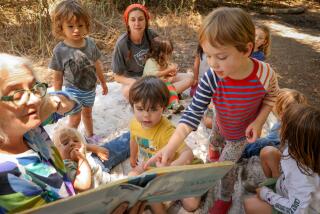Zoo Class Turns Into a Jungle
It’s a bit like “The Apprentice,” except the jungles of Manhattan have been replaced by the wilds of the Santa Barbara Zoo.
This semester, about two dozen Cal State Channel Islands students have been packing the boardroom at the city zoo, splitting into teams to work up proposals for new exhibits at the ocean-view park.
It’s not a competition and no one will get fired. The only thing riding on the exercise is a semester grade.
But in this rare classroom setting, where lessons revolve around lowland gorillas and ring-tailed lemurs, that hasn’t prevented students’ competitive instincts from taking hold.
“We’re taking it very seriously. We sort of don’t want to share too much information,” said junior Katie Lanes, whose group plans to pitch a wallaby sanctuary.
The team is so serious that one member drove to the Phoenix Zoo this weekend to study its wallaby exhibit.
“We want to create something that could really be used by the zoo,” she said. “We’re definitely going to sell the idea.”
It’s unlikely any of the proposals will become a reality at the small Santa Barbara Zoo.
The upper-division course is designed to teach students at the Camarillo campus all that goes into running a zoo as a way to explore careers and learn how organizations function.
Zoo officials play host to some of the lectures and provide personnel to teach topics such as the basics of veterinary care and how to run concessions. Staff members also will help assess the final team projects when they are presented Dec. 17.
The intent isn’t to put the exhibit proposals into practice; the zoo relies on its master plan to guide such decisions. Still, education curator Kirsten Friar said the zoo was always open to new ideas.
“If a group comes up with just a phenomenal idea we had never thought of, I would say it would get some real consideration,” said Friar, who worked on the curriculum with Cal State Channel Islands professor Dennis Muraoka. “So many of the students are not from the zoo field. They are from different disciplines, and I think that opens up enormous opportunities for innovative ideas,” Friar said. “We’re always wondering where our future leaders will come from. Maybe some of these students will turn out to be among them.”
Muraoka started laying the groundwork for the class more than a year ago.
After learning about a similar course that explored operations at the Getty Center, the Santa Barbara resident set out to apply the concept to his hometown zoo.
Muraoka teaches the course with professor Alex McNeill, although the class is largely student-driven. So far students have learned about the history of zoos and efforts to promote conservation and wildlife education. They have also learned about animal care, marketing and fundraising.
The idea was to get students to view the organization from a broader perspective, Muraoka said. Those lessons also reinforce the university’s commitment to interdisciplinary education, in which students explore various fields.
“Really it’s about gaining a greater understanding of the zoo as a social institution,” said Muraoka, who sees the potential to apply the same principles to other nonprofits.
“One of the things I wanted students to see is that if they want to become accountants, they need accountants at the zoo. They need writers at the zoo and they need biologists at the zoo,” Muraoka said. “I wanted them to see it doesn’t matter what their majors are. If they have an area of interest, there are career opportunities available.”
Taking a page from Dr. Seuss’ “If I Ran the Zoo,” the students have been serious about their assignments.
One team is working on a mountain lion exhibit and plans to create a small model of what the real display would look like.
Sophomore biology major Brooke Mills, a Santa Barbara native and former zoo employee, said the exhibit was meant to educate the public at a time of escalating conflict between people and the big cats.
“With more houses rising up against the mountains, the more you have people coming into contact with them,” she said. “We want to show the public they are just animals, they do need protection. They are not the killers everyone thinks they are.”
One group is pitching a plan to remake the petting zoo, stocking it with miniature cows, small horses and pygmy goats. Another is drafting plans to establish an enclosure for the bony-headed cassowary, a large, flightless bird found in rain forests and thought to be related to dinosaurs.
Then there is the group of business majors creating an Australian-themed exhibit complete with kangaroos and platypuses. Senior Cathy Ott said the course has been an eye-opener, especially for a group normally focused on the bottom line.
“I never really thought much about the zoo before this,” said Ott, who is among those feeling the competitive pressure build as the deadline for team projects draws near.
“I think everyone wants to show how great they are, especially in such a unique class,” she said. “Because it’s so creative, so detail-oriented, you definitely want to prove that you’ve done your homework and you know what you’re talking about.”
More to Read
Sign up for Essential California
The most important California stories and recommendations in your inbox every morning.
You may occasionally receive promotional content from the Los Angeles Times.










